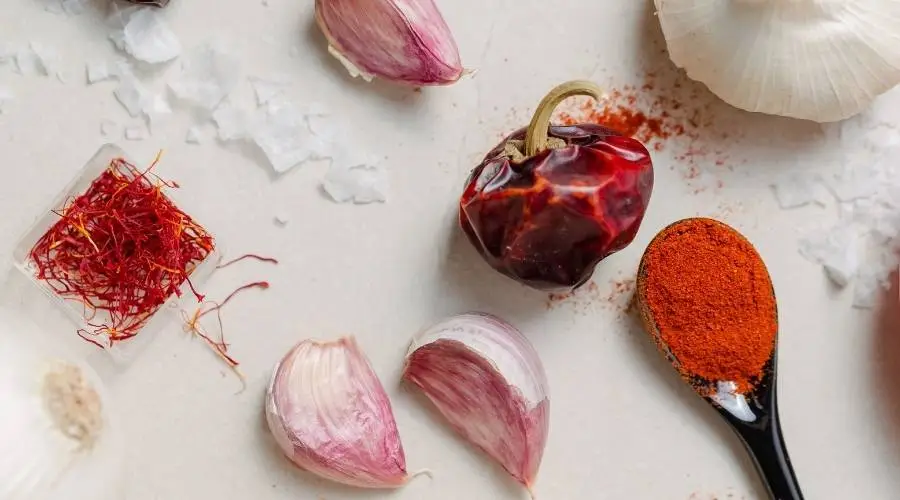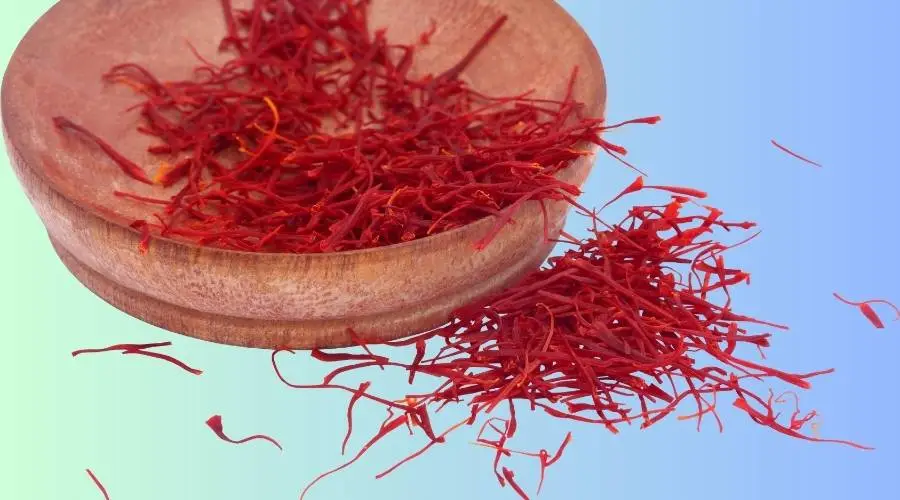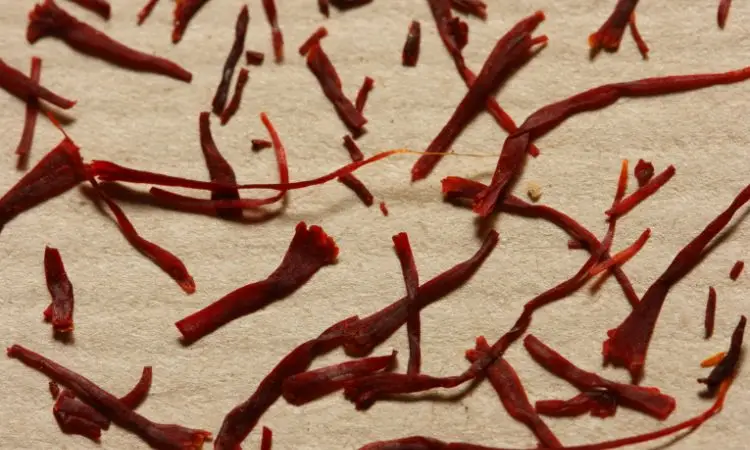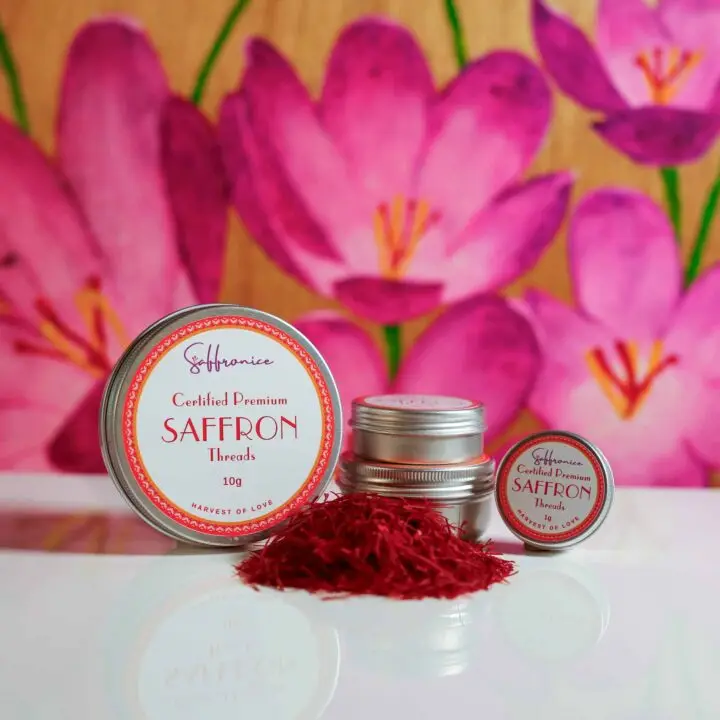Are you curious about saffron’s role in ancient healing? This precious spice has been a cornerstone of traditional medicine for millennia, transcending geographical boundaries and cultural differences. From the ancient temples of Persia to the healing halls of Greek physicians, saffron’s therapeutic legacy spans thousands of years.
Let’s explore how saffron has been used for healing across civilizations. We’ll examine its rich historical journey, traditional applications, and how modern science is validating what ancient healers knew intuitively. Discover the secrets of this golden thread and how it continues to bridge ancient wisdom with contemporary medicine.
🔑 Key Takeaways:
- Saffron has been revered as a medicinal herb across ancient cultures for over 3,500 years
- Traditional healers used saffron for everything from mood disorders to respiratory ailments
- Active compounds like crocin, crocetin, and safranal provide scientifically validated therapeutic effects
- Ancient preparation methods laid the foundation for modern herbal medicine practices
- Integration of traditional knowledge with contemporary research offers comprehensive healthcare approaches

The Historical Significance of Saffron in Traditional Medicine
Saffron, the most expensive spice in the world, has been valued for its healing powers since ancient times. This precious crimson stigma has been an integral part of healing traditions across diverse cultures, demonstrating the universal recognition of its therapeutic potential.
Early Civilizations and Medicinal Uses
The use of saffron in medicine dates back thousands of years, with archaeological and textual evidence revealing its prominence in early human societies. Ancient Sumerian, Assyrian, and Babylonian cultures utilized wild crocuses—the botanical source of saffron—in their medicinal remedies and as a valuable dye. These early applications demonstrate humanity’s long-standing relationship with this remarkable plant.
The Minoan civilization of ancient Greece provides some of the earliest visual documentation of saffron’s significance. Frescoes dating to approximately 1600 BCE depict saffron-like plants and gathering scenes, suggesting not only agricultural cultivation but also recognition of the plant’s medicinal value. These artistic representations offer fascinating glimpses into how ancient societies integrated saffron into their daily lives and healing practices.
Food Scientist’s Note: The consistency of saffron’s use across such diverse ancient civilizations suggests that its therapeutic properties were discovered independently multiple times, indicating observable and reproducible benefits that transcended cultural boundaries.
Cultural Integration in Ancient Healing Practices
Saffron’s role in traditional medicine systems is evident from its widespread adoption across ancient cultures. In Egypt, archaeological discoveries from tombs dating to the 15th and 14th centuries BCE reveal Cretan ambassadors bringing saffron-dyed textiles as tribute, highlighting the spice’s considerable value and prestige in diplomatic exchanges.
In ancient Persia (modern-day Iran), saffron was considered a royal remedy, reserved for the elite and used in elaborate healing rituals. Persian physicians documented its use for treating melancholy, digestive disorders, and respiratory conditions. The spice was so highly valued that it appeared in royal carpets and funeral shrouds, symbolizing both wealth and spiritual significance.
Greek and Roman physicians also extensively documented saffron’s medicinal applications. Hippocrates, the father of Western medicine, prescribed saffron for various ailments. The Greek physician Dioscorides included detailed descriptions of saffron’s therapeutic uses in his first-century work “De Materia Medica,” which remained a medical authority for over 1,500 years.
Documentation in Historical Medical Texts
Historical medical texts provide invaluable insights into saffron’s therapeutic applications across different healing traditions. These ancient manuscripts reveal a sophisticated understanding of the spice’s properties and appropriate applications:
Ancient Greek and Roman Texts:
- Prescribed for gynecological conditions and menstrual regulation
- Used as an antidote for poisoning
- Recommended for liver and spleen disorders
- Applied topically for wound healing
Persian and Arabic Medicine:
- Documented in the works of Avicenna (Ibn Sina) as a heart tonic
- Used for treating depression and anxiety
- Prescribed for digestive complaints and appetite stimulation
- Applied in eye preparations for vision enhancement
Traditional Chinese Medicine:
- Integrated into formulas for blood circulation
- Used for emotional balance and “moving stagnant qi”
- Applied in women’s health formulations
- Considered warming and energizing
The comprehensive documentation across these diverse medical traditions validates saffron’s remarkable therapeutic versatility and the sophisticated medical knowledge of ancient practitioners.
Understanding Saffron’s Botanical Properties
The saffron spice we treasure today comes from the vibrant purple flowers of the Crocus sativus plant, a remarkable species with a fascinating botanical history. This plant has captivated humanity for thousands of years, with its cultivation and propagation representing one of the earliest examples of selective plant breeding.
Unlike its wild relatives, the saffron crocus cannot reproduce through seeds due to its unique genetic makeup. Instead, it propagates through corm division, a process first documented by the ancient Greek philosopher Theophrastus in his botanical writings. This asexual reproduction method has been essential to maintaining the plant’s valuable characteristics throughout millennia of cultivation.
Chef’s Professional Tip: The inability of Crocus sativus to produce viable seeds means that every saffron crocus in the world today is a genetic clone descended from the original domesticated plants. This genetic uniformity ensures consistent quality but also makes the species entirely dependent on human cultivation for survival.
Botanical Characteristics
Saffron’s botanical composition reveals why ancient cultivators found it so valuable:
| Saffron Botany Fact | Details |
|---|---|
| Number of Crocus Species | Approximately 250 worldwide |
| Geographic Origin | South and Central Europe to Western China |
| Reproduction Method | Asexual corm division exclusively |
| Genetic Composition | Triploid (three sets of chromosomes) with a large, repetitive genome |
| Flower Characteristics | Purple petals with three crimson stigmas per flower |
| Harvesting Window | Brief autumn blooming period of 2-3 weeks |
The triploid nature of Crocus sativus—possessing three copies of every chromosome instead of the usual two—makes it a fascinating subject for botanical research. This unusual genetic configuration contributes to the plant’s sterility but may also enhance the concentration of bioactive compounds that give saffron its medicinal properties.
Understanding these botanical properties helps explain why ancient civilizations invested such effort in cultivating and preserving this plant. The labor-intensive harvest and careful propagation required reflected not just the spice’s culinary value but also its recognized therapeutic importance.
Origins and Domestication of Medicinal Saffron
The journey of saffron from wild flower to cultivated medicine spans millennia and crosses continents. Recent genetic and archaeological research has illuminated this fascinating domestication story, revealing how human selection shaped this remarkable plant.
Bronze Age Greek Cultivation
The domestication of saffron likely occurred in Bronze Age Greece around 1700-1600 BCE, making it one of the earliest cultivated medicinal plants. The Minoan civilization of Crete provides compelling evidence through elaborate frescoes depicting saffron gathering and processing.
Two particularly significant frescoes—”The Saffron Gatherers” and “The Adorants” from the island of Santorini (ancient Thera)—show detailed scenes of saffron collection, dating to approximately 1600 BCE. These artworks don’t merely depict agricultural activity; they suggest ritualistic significance, indicating that saffron held both medicinal and spiritual importance in Minoan culture.
Groundbreaking genetic research published in 2019 traced the modern saffron crocus back to Crocus cartwrightianus, a wild species native to mainland Greece and Crete. This study revealed that ancient Greek cultivators selectively bred plants with longer, more vibrant stigmas and enhanced aromatic properties, gradually creating the Crocus sativus we know today.
Food Scientist’s Note: The domestication process likely took generations, with cultivators carefully selecting corms from plants displaying the most desirable characteristics. This patient, multi-generational effort represents sophisticated agricultural knowledge and long-term planning by Bronze Age societies.
Spread Across Mediterranean Regions
From its Greek origins, saffron cultivation spread throughout the ancient Mediterranean world, carried by traders, conquerors, and migrating populations. Each region that adopted saffron cultivation developed unique applications and preparation methods, contributing to a rich tapestry of medicinal knowledge.
Mediterranean Expansion Timeline:
- 1500-1000 BCE: Spread to Egypt and the Levant
- 1000-500 BCE: Established in Persia and Mesopotamia
- 500 BCE-100 CE: Adopted throughout Roman territories
- 700-1000 CE: Introduced to Spain by Arab traders
- 1000-1500 CE: Cultivation reaches Northern Europe and India
The spice’s medicinal reputation preceded its arrival in new regions, with traders sharing knowledge of therapeutic applications alongside the corms themselves. This knowledge transfer created a cumulative medical wisdom that transcended individual cultures.
Evolution of Cultivation Techniques
Saffron cultivation techniques evolved significantly over millennia, with each culture contributing innovations based on local conditions and accumulated experience. Ancient cultivators discovered that saffron thrived in specific soil conditions and climate patterns, knowledge that remains relevant in modern cultivation.
Traditional cultivation practices developed by ancient farmers included:
- Corm Selection: Careful choosing of the healthiest corms for propagation
- Soil Preparation: Enriching soil with organic matter and ensuring proper drainage
- Planting Depth: Precise spacing and depth for optimal growth
- Harvest Timing: Gathering flowers at dawn for maximum potency
- Drying Methods: Controlled drying to preserve bioactive compounds
These time-tested techniques, refined over thousands of years, demonstrate the sophisticated agricultural knowledge of ancient civilizations. Modern research has validated many of these traditional practices, confirming the wisdom of ancient cultivators.
| Global Saffron Statistics | Value |
|---|---|
| Global Production (2018) | Approximately 88% from Iran |
| Price per Kilogram | US$5,000 or higher |
| Stigmas per Kilogram | 440,000 individual stigmas |
| Labor Requirements | 40 hours to pick 150,000 flowers |
| Dried Saffron Yield | 1 gram from 150 flowers |
| Active Compounds | 28 volatile and aroma-yielding compounds |
Saffron Folk Remedies Through the Ages
Saffron’s journey through folk medicine reveals a remarkable consistency in its therapeutic applications across diverse cultures and time periods. This convergence of traditional knowledge from independent sources provides compelling evidence for the spice’s genuine medicinal properties.
Ancient Mesopotamian Applications
In ancient Mesopotamia, saffron appeared in some of the earliest written medical texts. Sumerian and Akkadian tablets describe its use for:
- Treating eye diseases and improving vision
- Alleviating menstrual complaints and childbirth difficulties
- Managing digestive disorders and stomach pain
- Addressing respiratory conditions and coughs
- Enhancing mood and treating melancholy
The consistency of these applications across ancient Near Eastern cultures suggests shared medical knowledge and observable therapeutic effects that reinforced continued use.
Mediterranean Traditional Uses
Greek and Roman folk medicine incorporated saffron extensively, with applications documented by physicians and mentioned in popular literature. Saffron was particularly valued for:
- Digestive Health: Taken in wine or water for stomach complaints
- Respiratory Relief: Mixed with honey for coughs and chest congestion
- Wound Healing: Applied topically to injuries and skin conditions
- Mood Enhancement: Consumed to alleviate sadness and promote cheerfulness
- Pain Relief: Used for headaches and general discomfort
Chef’s Professional Tip: Ancient Greek physicians often combined saffron with wine for medicinal preparations. The alcohol helped extract saffron’s bioactive compounds while the pleasant taste made remedies more palatable—an early example of pharmaceutical formulation science.
Persian and Indian Traditions
In Persian medicine, saffron held a prestigious position among medicinal herbs. Persian physicians developed sophisticated preparations and documented specific dosages—an advanced approach for ancient medicine. The spice was particularly renowned for:
- Strengthening the heart and improving circulation
- Treating depression and anxiety (conditions they called “melancholia”)
- Enhancing memory and cognitive function
- Supporting liver health and detoxification
- Improving sexual vitality
In Indian Ayurvedic medicine, saffron (known as “kesar” or “kumkuma”) was classified as a “tridoshic” herb, meaning it could balance all three bodily humors. Ayurvedic practitioners used saffron for:
- Balancing “pitta” (heat) in the body
- Supporting mental clarity and consciousness
- Enhancing skin complexion and radiance
- Strengthening the heart and reproductive systems
- Promoting spiritual awareness in meditation practices
Traditional Chinese Medicine also incorporated saffron, though it arrived somewhat later through the Silk Road trade. Chinese physicians valued it for “invigorating blood” and “dispersing stagnation,” using it primarily in women’s health formulations and for emotional balance.

The Science Behind Traditional Saffron Healing
Modern scientific research has begun validating what ancient healers knew intuitively about saffron’s therapeutic properties. The convergence of traditional knowledge and contemporary research provides a comprehensive understanding of how this remarkable spice affects human health.
Active Compounds and Their Effects
Saffron’s healing properties stem from its complex chemical composition, containing over 150 identified compounds. The most significant bioactive components include:
Primary Therapeutic Compounds:
- Crocin: The carotenoid responsible for saffron’s golden color, crocin demonstrates powerful antioxidant properties and has been shown to cross the blood-brain barrier, potentially explaining saffron’s cognitive and mood-enhancing effects.
- Crocetin: A breakdown product of crocin, crocetin exhibits anti-inflammatory properties and may improve oxygen delivery to tissues, supporting traditional uses for respiratory and circulatory conditions.
- Safranal: Producing saffron’s distinctive aroma, safranal has demonstrated anxiolytic (anti-anxiety) and sedative effects, validating traditional uses for emotional balance and sleep support.
- Picrocrocin: Responsible for saffron’s slightly bitter taste, this compound shows antioxidant and potential anticancer properties in laboratory studies.
Food Scientist’s Note: The synergistic interaction between these compounds likely produces effects greater than any single component alone. This phenomenon, known as the “entourage effect,” may explain why whole saffron preparations often show more robust effects than isolated compounds in research studies.
Modern Research Validation
Contemporary scientific research has investigated saffron’s traditional medicinal applications using rigorous clinical methodologies. Science-backed research has confirmed several traditional uses:
Mood Disorders and Depression: Multiple clinical trials have demonstrated that saffron supplementation can significantly improve symptoms of mild to moderate depression, with effects comparable to standard antidepressant medications but with fewer side effects. A 2018 meta-analysis of randomized controlled trials confirmed these findings, lending strong support to saffron’s traditional use for “melancholia.”
Antioxidant and Anti-inflammatory Effects: Laboratory studies have confirmed saffron’s potent antioxidant capacity and its anti-inflammatory properties. Research shows that saffron compounds can reduce inflammatory markers and protect cells from oxidative damage, supporting traditional uses for various inflammatory conditions.
Cognitive Function: Studies examining saffron’s effects on memory and cognitive performance have shown promising results, particularly in age-related cognitive decline. This validates ancient uses for enhancing mental clarity and memory.
Metabolic Health: Research has demonstrated that saffron can help regulate blood sugar levels in people with type 2 diabetes and may support weight management by reducing appetite—findings that align with traditional uses for digestive and metabolic support.
Therapeutic Mechanisms
Understanding how saffron works at a molecular level helps bridge ancient wisdom with modern medicine:
Neurotransmitter Modulation: Saffron compounds influence brain chemistry by affecting neurotransmitters like serotonin, dopamine, and norepinephrine. This mechanism explains its traditional use for mood disorders and aligns with how modern antidepressants work.
Anti-inflammatory Pathways: Saffron inhibits pro-inflammatory enzymes and reduces inflammatory cytokines, potentially helping with conditions characterized by chronic inflammation.
Antioxidant Defense: By neutralizing free radicals and supporting the body’s own antioxidant systems, saffron protects cells from damage and may slow aging processes—concepts that ancient healers understood intuitively even without modern terminology.
Hormonal Influence: Research suggests saffron may influence hormonal balance, particularly in women, supporting its traditional use for menstrual disorders and reproductive health.
| Research Area | Key Findings | Traditional Use Validated |
|---|---|---|
| Depression & Anxiety | Effective in clinical trials | Yes – mood enhancement |
| Cognitive Function | Improves memory and learning | Yes – mental clarity |
| Inflammation | Reduces inflammatory markers | Yes – various inflammatory conditions |
| Antioxidant Activity | Powerful free radical scavenging | Yes – general health tonic |
| Blood Sugar Control | Helps regulate glucose levels | Partially – metabolic support |
Traditional Preparation Methods and Applications
Ancient healers developed sophisticated methods for preparing and administering saffron remedies, demonstrating a remarkable understanding of extraction techniques and dosing principles. These traditional preparation methods often maximize the bioavailability of saffron’s active compounds, as modern science has confirmed.
Infusions and Decoctions
The most common traditional preparation involved steeping saffron threads in hot water to create medicinal infusions. This simple yet effective method extracts water-soluble compounds while preserving heat-sensitive components. Ancient physicians understood that the golden color’s intensity indicated the preparation’s strength.
Traditional Infusion Method:
- 5-7 saffron threads per cup of hot water
- Steep for 10-15 minutes
- Consume warm, often sweetened with honey
- Used for mood support, digestive complaints, and general wellness
This traditional approach forms the basis for modern saffron tea preparations, which continue to be valued for their gentle yet effective therapeutic effects.
Topical Applications
Ancient healers also applied saffron externally, mixing it with various carriers for different conditions:
- Wound Healing: Mixed with honey or oils for antibacterial and healing properties
- Skin Conditions: Combined with milk or yogurt for complexion enhancement
- Joint Pain: Prepared as poultices with other herbs for anti-inflammatory effects
- Eye Care: Carefully prepared dilutions for eye inflammation (though modern practitioners advise caution with this application)
Chef’s Professional Tip: Ancient texts often recommend warming saffron gently before use to release its aromatic compounds. This traditional practice aligns with modern understanding that mild heat can enhance the extraction of bioactive components without degrading them.
Combination Formulas
Traditional medicine systems rarely use herbs in isolation; instead, they create synergistic combinations tailored to individual conditions. Saffron was frequently paired with:
- Honey: For respiratory conditions and as a general health tonic
- Milk: To support sleep and calm the nervous system
- Wine or alcohol: For the extraction and preservation of medicinal properties
- Other herbs: Combined based on traditional formulas for specific conditions
These multi-ingredient preparations demonstrate the sophisticated pharmaceutical knowledge of ancient healers, who understood that combining remedies could enhance or modify effects.
Modern Clinical Evidence Supporting Ancient Uses
The validation of traditional saffron uses through contemporary research represents an exciting convergence of ancient wisdom and modern science. Rigorous clinical studies have examined many of saffron’s historical applications, providing evidence-based support for centuries-old healing practices.
Research Studies and Findings
Depression and Mood Disorders: Systematic reviews analyzing multiple clinical trials have consistently shown that saffron supplementation (typically 30mg daily) significantly improves symptoms of mild to moderate depression. A 2019 meta-analysis examined data from over 400 participants across multiple studies, concluding that saffron’s antidepressant effects were comparable to standard medications but with better tolerability.
Cognitive Enhancement: Studies in both healthy individuals and those with mild cognitive impairment have demonstrated that saffron can improve memory, learning, and processing speed. One notable study showed that 30mg of saffron daily for 16 weeks significantly improved cognitive function in adults with Alzheimer’s disease.
Women’s Health: Research has validated traditional uses of saffron for premenstrual syndrome (PMS), showing a significant reduction in physical and psychological symptoms. Studies have also explored its effects on menopausal symptoms, with promising preliminary results.
Metabolic Health: Clinical trials have demonstrated that saffron can help reduce appetite and food cravings, supporting weight management efforts. Additionally, studies in people with type 2 diabetes show improved blood sugar control and reduced inflammation markers.
Contemporary Medical Applications
Modern healthcare practitioners are increasingly incorporating saffron into integrative treatment approaches:
- Complementary Depression Treatment: Used alongside or as an alternative to conventional antidepressants
- Cognitive Support: Recommended for age-related memory concerns and neurodegenerative conditions
- Mood Regulation: Applied in stress management and anxiety protocols
- Metabolic Support: Integrated into weight management and diabetes care programs
Safety and Efficacy Data
Understanding appropriate dosing and potential side effects is crucial for safe use:
Generally Recognized Safe Doses:
- 30-50mg daily for therapeutic effects
- Up to 1.5 grams is considered safe for most adults
- Higher doses may cause adverse effects
Potential Side Effects:
- Mild: dry mouth, dizziness, nausea (rare at recommended doses)
- Pregnancy: high doses may stimulate uterine contractions (should be avoided)
- Drug Interactions: may interact with antidepressants and blood pressure medications
Food Scientist’s Note: The therapeutic dose of saffron is much higher than typical culinary use but far below toxic levels. This wide safety margin has contributed to saffron’s enduring use across millennia—effective doses are safe, and adverse effects are typically mild and reversible.
Integration of Saffron in Modern Holistic Medicine
The resurgence of interest in natural remedies has positioned saffron as a bridge between traditional healing wisdom and evidence-based complementary medicine. Modern practitioners are rediscovering how to incorporate this ancient remedy into contemporary wellness approaches.
Contemporary Holistic Applications
Integrative healthcare providers now use saffron in various contexts:
Mental Health Support:
- Adjunct therapy for mild to moderate depression
- Natural anxiety management
- Sleep quality improvement
- Stress resilience enhancement
Cognitive Wellness:
- Age-related memory support
- Focus and concentration enhancement
- Neuroprotective protocols for brain health
- Alzheimer’s disease complementary treatment
Physical Health:
- Anti-inflammatory support for chronic conditions
- Antioxidant protection against cellular aging
- Metabolic health and weight management
- Women’s hormonal balance
Preventive Medicine: Modern practitioners increasingly recommend saffron as part of preventive health strategies, recognizing that its broad-spectrum benefits align with the holistic goal of supporting overall wellness rather than just treating specific diseases.
Evidence-Based Integration
The integration of saffron into modern practice relies on:
- Quality Standardization: Using verified, high-quality saffron products
- Appropriate Dosing: Following research-supported dosing protocols
- Individual Assessment: Tailoring recommendations to individual needs
- Monitoring: Tracking responses and adjusting as needed
- Safety Screening: Checking for contraindications and interactions
This evidence-based approach honors traditional knowledge while ensuring safety and efficacy through modern scientific validation.
Conclusion
Saffron’s journey from ancient remedy to modern therapeutic agent demonstrates the enduring value of traditional healing wisdom. Over 3,500 years of human experience with this remarkable spice has created a rich legacy of medicinal knowledge that contemporary research continues to validate and refine.
The convergence of ancient practice and modern science reveals that traditional healers possessed a sophisticated understanding of saffron’s therapeutic properties, even without access to molecular biology or controlled clinical trials. Their careful observations and accumulated experience created a foundation upon which current health research continues to build.
As we move forward, the challenge lies in preserving traditional knowledge while applying rigorous scientific methods to understand mechanisms and optimize applications. This integrated approach—respecting ancient wisdom while demanding modern evidence—offers the most promising path for unlocking saffron’s full therapeutic potential.
Whether you’re drawn to saffron for its historical significance, its scientifically validated benefits, or its role in holistic wellness, this golden spice represents a beautiful example of how traditional medicine and modern science can complement each other, offering insights into natural healing that transcend time and culture.
FAQ
What are the historical medicinal uses of saffron?
Saffron has been used in folk remedies for over 3,500 years across multiple civilizations. Ancient Sumerians, Assyrians, Greeks, Persians, and Egyptians used it for mood disorders, digestive complaints, respiratory conditions, women’s health issues, wound healing, and as a general health tonic. Historical medical texts from diverse cultures document remarkably consistent therapeutic applications.
What are the unique botanical properties of saffron?
Saffron comes from Crocus sativus flowers and is unique because it’s a sterile triploid plant that cannot reproduce from seeds. It propagates exclusively through corm division, making it entirely dependent on human cultivation. This unusual genetic makeup contributes to its high concentration of bioactive compounds and consistent quality across all cultivated plants.
Where did saffron originate, and how was it domesticated?
Saffron domestication likely began in Bronze Age Greece around 1700 BCE. Genetic studies trace it to Crocus cartwrightianus, native to Greece and Crete. Minoan frescoes from 1600 BCE show saffron cultivation and gathering. Ancient Greek farmers selectively bred plants with longer, more aromatic stigmas, creating the modern saffron crocus over multiple generations.
What traditional preparation methods were used for saffron folk remedies?
Traditional preparation methods included infusions (steeping threads in hot water), decoctions (boiling for stronger extraction), topical applications mixed with honey or oils, and combination formulas with other herbs. Saffron was often dissolved in wine or milk for internal use and applied externally as a poultice for skin conditions and wounds. These methods maximized the extraction of bioactive compounds.
How has modern research validated traditional medicinal uses of saffron?
Modern clinical studies have confirmed saffron’s effectiveness for depression and anxiety, cognitive enhancement, anti-inflammatory effects, and metabolic support. Research identifies compounds like crocin, crocetin, and safranal as responsible for these effects. Multiple systematic reviews and meta-analyses support traditional uses, particularly for mood disorders, where saffron shows effects comparable to conventional antidepressants.
How is saffron being integrated into modern holistic and complementary medicine?
Practitioners now use saffron as adjunct therapy for depression, cognitive support for aging, stress management, and metabolic health. It’s incorporated into evidence-based protocols with standardized dosing (typically 30-50mg daily), quality verification, and safety screening. This integration respects traditional knowledge while ensuring safety and efficacy through scientific validation and careful monitoring.



